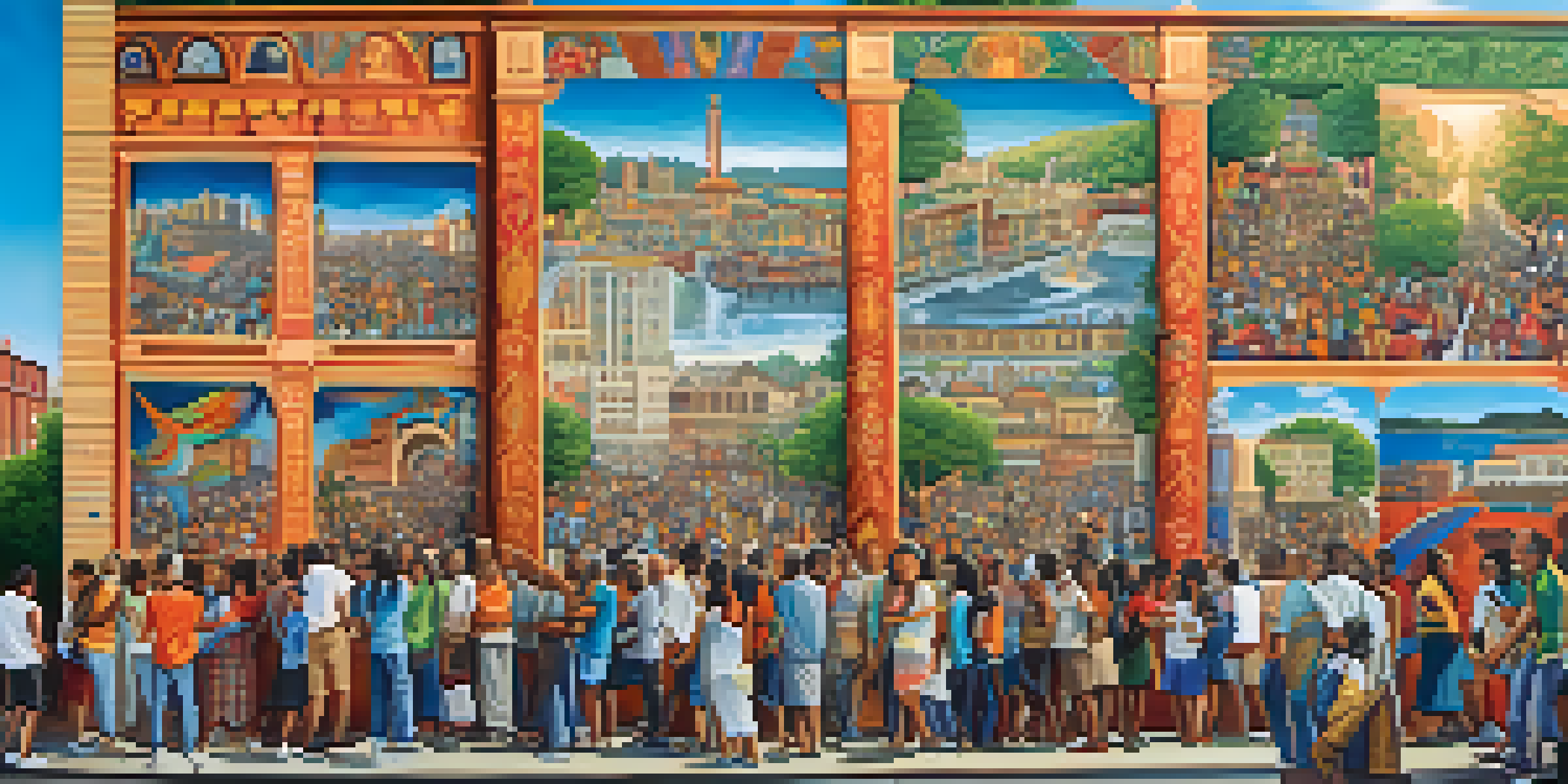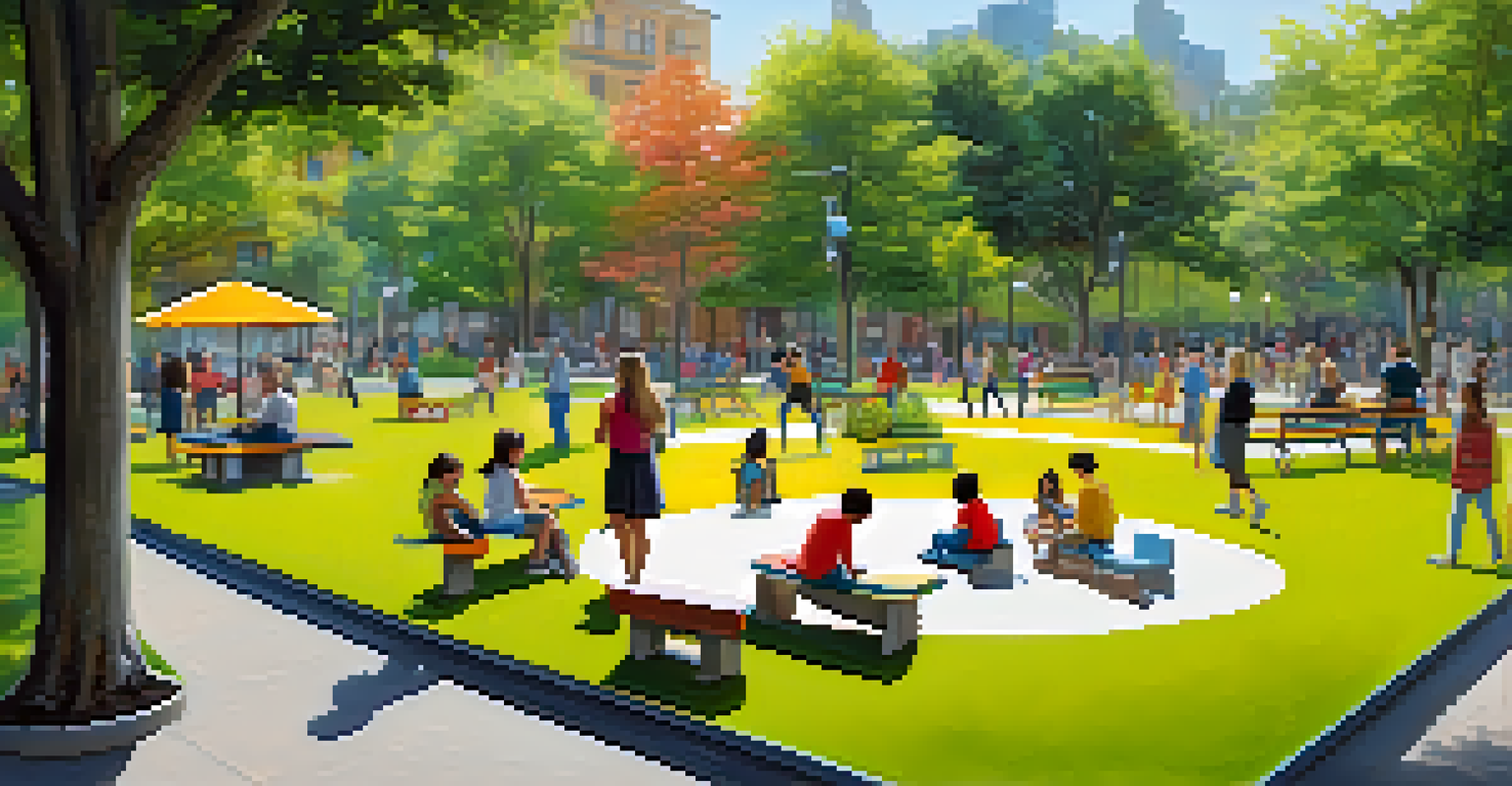The Connection Between Public Art and Social Cohesion

Understanding Public Art and Its Role in Communities
Public art encompasses a wide range of creative expressions found in public spaces, from murals to sculptures. This form of art is not just about beautifying a place; it serves as a reflection of community identity and values. By showcasing local culture, public art can create a sense of belonging among residents, making them feel more connected to their environment.
Public art is a reflection of the community's identity and serves as a bridge to connect individuals through shared experiences.
Think of a vibrant mural on a city wall that tells the story of its neighborhood. This artwork can spark conversations among passersby, drawing them into the narrative of their community. As people engage with the art, they start to share their own stories and experiences, fostering a deeper relationship with one another.
In essence, public art acts as a bridge, linking individuals through shared experiences and cultural narratives. This connection is vital for building social cohesion, as it encourages collaboration and mutual understanding among diverse groups within a community.
Art as a Catalyst for Community Engagement
Public art projects often involve community participation, which is crucial for fostering engagement. When residents are invited to contribute ideas or even take part in the creation process, they invest their time and energy into the project. This sense of ownership leads to a stronger bond among community members, as they work together towards a common goal.

For example, a community garden that features art installations created by local artists can bring together neighbors to not only beautify the space but also to cultivate relationships. As people gather to plant flowers or paint murals, they share laughter, stories, and sometimes meals, transforming a simple project into a vibrant social event.
Public Art Enhances Community Identity
Public art reflects local culture and fosters a sense of belonging among residents.
Ultimately, when communities come together to create art, they are not just enhancing their physical environment; they are also nurturing social ties that can lead to lasting relationships. These interactions help build a sense of trust and collaboration, vital components of social cohesion.
Public Art and Cultural Identity
Public art serves as a powerful medium for expressing cultural identity within communities. Through art, local histories, traditions, and values can be communicated in a way that resonates with residents and visitors alike. This representation is particularly important for marginalized groups, as it provides them with a platform to share their stories.
Art is not what you see, but what you make others see.
Imagine a series of statues in a park that celebrate the cultural diversity of a city. Each statue tells a different story, reflecting the rich tapestry of the community's heritage. Such artistic expressions not only educate the public but also instill pride in residents, reinforcing their sense of belonging.
By honoring different cultural identities through public art, communities can cultivate an inclusive atmosphere. This inclusivity promotes understanding and respect among diverse groups, ultimately contributing to stronger social cohesion.
Art and Public Spaces: A Shared Experience
Public art transforms ordinary spaces into vibrant gathering spots, inviting people to come together. Parks, sidewalks, and plazas adorned with art become communal hubs where individuals from all walks of life can interact. These spaces encourage socialization and community-building in a relaxed, informal setting.
Consider a park featuring a large interactive art installation. Children might play nearby while adults engage in conversations, all sparked by the shared experience of enjoying the art. These interactions can lead to new friendships and connections, as people feel more at ease in a creative environment.
Art Drives Community Engagement
Collaborative art projects encourage participation, strengthening social ties and community bonds.
When public spaces are enriched with art, they become more than just places to pass through; they evolve into venues for social interaction and community bonding. This shared experience is crucial for enhancing social cohesion, as it allows people to connect over common interests and experiences.
Public Art as a Tool for Social Change
Art has long been a vehicle for social change, and public art is no exception. Through powerful imagery and thought-provoking messages, artists can address pressing social issues, sparking dialogue among community members. This engagement encourages individuals to reflect on their values and the challenges facing their community.
For instance, a mural depicting the struggles of homelessness can raise awareness and evoke empathy in viewers. Such art can motivate residents to take action, whether by volunteering or advocating for policy changes. In this way, public art not only fosters social cohesion but also empowers communities to work towards improvement.
By highlighting social issues, public art creates a platform for conversation and collaboration. As community members come together to address these challenges, they strengthen their bonds, cultivating a united front in the pursuit of social change.
Collaborative Art Projects and Community Building
Collaborative art projects are a fantastic way to bring communities together. These initiatives often invite residents to participate in the creative process, encouraging teamwork and mutual support. By working side by side, participants forge connections that transcend social barriers, fostering a sense of belonging.
Imagine a neighborhood organizing a mural project where residents of all ages contribute their artistic talents. As they paint together, laughter and conversation flow, creating an atmosphere of camaraderie. The finished mural becomes a symbol of their collective efforts, reinforcing their shared identity and pride.
Public Art Sparks Social Change
Art can address social issues, inspiring dialogue and motivating communities to take action.
These collaborative experiences not only produce beautiful art but also strengthen social ties. When community members actively engage in creating something meaningful, they build trust and rapport, essential ingredients for social cohesion.
The Lasting Impact of Public Art on Social Cohesion
The influence of public art on social cohesion extends far beyond the initial creation process. Over time, these art pieces become integral to the community's identity and heritage. They serve as reminders of shared experiences, collective struggles, and triumphs, fostering a sense of continuity and belonging among residents.
Consider how a beloved public artwork can become a gathering point for celebrations or discussions, drawing people together over the years. This ongoing connection can keep the spirit of community alive, encouraging future generations to appreciate and contribute to their surroundings.

In essence, the lasting impact of public art on social cohesion is profound. By nurturing connections and fostering a sense of pride, public art helps create resilient communities that thrive on collaboration and understanding.